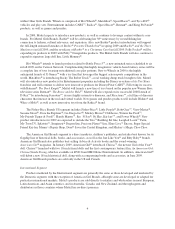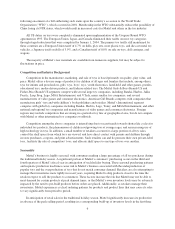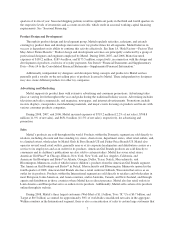Mattel 2008 Annual Report Download - page 18
Download and view the complete annual report
Please find page 18 of the 2008 Mattel annual report below. You can navigate through the pages in the report by either clicking on the pages listed below, or by using the keyword search tool below to find specific information within the annual report.peak demand times may affect Mattel’s ability to deliver its products in time to meet retailer demand. These
factors may decrease sales or increase the risks that Mattel may not be able to meet demand for certain products
at peak demand times or that Mattel’s own inventory levels may be adversely impacted by the need to pre-build
products before orders are placed.
Mattel has significant customer concentration, so that economic difficulties or changes in the purchasing
policies or patterns of its major customers could have a significant impact on Mattel’s business and
operating results.
A small number of customers account for a large share of Mattel’s net sales. In 2008, Mattel’s three largest
customers, Wal-Mart, Toys “R” Us and Target, in the aggregate, accounted for approximately 38% of net sales,
and its ten largest customers, in the aggregate, accounted for approximately 47% of net sales. The concentration
of Mattel’s business with a relatively small number of customers may expose Mattel to a material adverse effect
if one or more of Mattel’s large customers were to significantly reduce purchases for any reason, favor
competitors or new entrants, or increase their direct competition with Mattel by expanding their private-label
business. Customers make no binding long-term commitments to Mattel regarding purchase volumes and make
all purchases by delivering one-time purchase orders. Any customer could reduce its overall purchases of
Mattel’s products, reduce the number and variety of Mattel’s products that it carries and the shelf space allotted
for Mattel’s products, or otherwise seek to materially change the terms of the business relationship at any time.
Any such change could significantly harm Mattel’s business and operating results.
Significant increases in the price of commodities, transportation or labor, if not offset by declines in other
input costs, or a reduction or interruption in the delivery of raw materials, components and finished
products from Mattel’s vendors could negatively impact Mattel’s financial results.
Cost increases, whether resulting from rising costs of materials, compliance with existing or future
regulatory requirements, transportation, services and labor could impact the profit margins realized by Mattel on
the sale of its products. Because of market conditions, timing of pricing decisions, and other factors, there can be
no assurance that Mattel will be able to offset any of these increased costs by adjusting the prices of its products.
Increases in prices of Mattel’s products could result in lower sales. Mattel’s ability to meet customer demand
depends, in part, on its ability to obtain timely and adequate delivery of materials, parts and components from its
suppliers and internal manufacturing capacity. Mattel has experienced shortages in the past, including shortages
of raw materials and components. Although Mattel works closely with suppliers to avoid these types of
shortages, there can be no assurance that Mattel will not encounter these problems in the future. A reduction or
interruption in supplies or in the delivery of finished products, whether resulting from more stringent regulatory
requirements, suppliers, disruptions in transportation, port delays, labor strikes, lockouts, or otherwise, or a
significant increase in the price of one or more supplies, such as fuel or resin (which is an oil-based product),
could negatively impact Mattel’s financial results.
Significant changes in currency exchange rates or the ability to transfer capital across borders could have
a material adverse effect on Mattel’s business and results of operations.
Mattel’s net investment in its foreign subsidiaries and its results of operations and cash flows are subject to
changes in currency exchange rates and regulations. Mattel seeks to mitigate the exposure of its results of
operations to fluctuations in currency exchange rates by partially hedging this exposure using foreign currency
forward exchange contracts. These contracts are primarily used to hedge Mattel’s purchase and sale of inventory,
and other intercompany transactions denominated in foreign currencies. Government action may restrict Mattel’s
ability to transfer capital across borders and may also impact the fluctuation of currencies in the countries where
Mattel conducts business or has invested capital. Significant changes in currency exchange rates, reductions in
Mattel’s ability to transfer its capital across borders, and changes in government-fixed currency exchange rates,
including the Chinese yuan and Venezuelan bolivar fuerte, could have a material adverse effect on Mattel’s
business and results of operations.
14
























